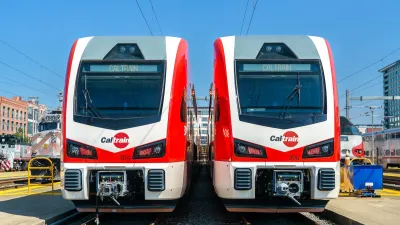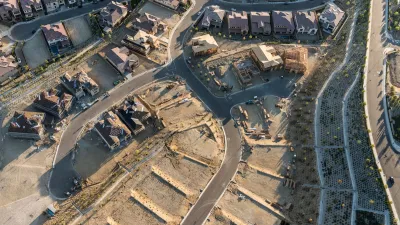Out in the bar, the world as we know it was coming to an end. In the backroom, meanwhile, smart people were trying to figure out the future of suburbia. The bar was in the lobby of a classic desert resort in Arizona. On the TV, CNN was delivering headlines of imminent doom. It was the last days of September, and the foundations of American finance were cracking under the strains of default and distrust.
Out in the bar, the world as we know it was coming to an end. In the backroom, meanwhile, smart people were trying to figure out the future of suburbia.
The bar was in the lobby of a classic desert resort in Arizona. On the TV, CNN was delivering headlines of imminent doom. It was the last days of September, and the foundations of American finance were cracking under the strains of default and distrust.
The people in the backroom were members of the Urban Land Institute (ULI) – 130 professionals whose business it was to design and build, under normal circumstances, the American Dream, western edition. They had come together not to respond to the crisis of the moment but to the crisis of the future. Their job was to creatively respond to the two inevitabilities they knew would change business as usual: more people and a warming climate.
In the next 30 years, 90 million more Americans will need somewhere to live, and many of them will choose the American West. Divide by 10, more or less, and assume the same for Canada. And then assume the climate will change.
On the morning of the second day, as Washington Mutual was collapsing live on the news channels, two scientists began the briefing. Their prognosis was unequivocal: given the carbon we have already emitted, the climate will change. The unknowns thereafter depend on our response – the changes we make in how we build and how we move.
Say this about the last half century of North American life: it's been the best that human beings have ever achieved, given our access to land, water, energy and money – unlimited in quantity, securely provided, cheap to afford. Ironically, of all those preconditions, money was thought to be the least problematic.
Four teams were charged with crafting new visions for sustainable development on the urban edge by balancing the demands of the market while reducing greenhouse gases and responding to rising energy prices. The ULI delegates weaved their way through the lobby on the way to their working groups, while on the TV the anchors could hardly keep up with developments about a financial system they could barely understand.
Themes emerged quickly: life would be more local, distances between destinations would be shorter, transportation options would be multiplied (winner of the most innovative option: the Flexhorse). There would be less waste of water, more solar energy, narrower streets, higher densities and a greater mix of uses.
The developers, architects and designers seemed as comfortable talking about net zero energy as net income. The checklists of sustainability and the nuances of LEED ratings were as familiar as pro formas. Green ideas had become boilerplate.
In truth, most of the renderings of the final products were also pretty familiar. Densities stayed low enough so that the production builders who provide most of the product (and who rarely attend ULI conferences) would not have to move too far from the single-family home or the townhouse. The task the ULI had undertaken could only deal with variations on existing suburban themes. In the end, the products for sale, the neighbourhoods envisioned and the urban regions extended had to be as aspirational and comfortable as any McMansion – just a hell of a lot greener.
It's the conundrum of our times. No plan for the future can ever say, in effect, that the assumptions on which our plans are based are likely to change due to some cataclysmic circumstance. Therefore, the conclusions are likely to be wrong and should be ignored. Instead, we have to plan as though the present will extend into the future along the same road we are already travelling, only in an electric car.
The TV in the bar was telling a very different story.
[From Business in Vancouver]

Alabama: Trump Terminates Settlements for Black Communities Harmed By Raw Sewage
Trump deemed the landmark civil rights agreement “illegal DEI and environmental justice policy.”

Planetizen Federal Action Tracker
A weekly monitor of how Trump’s orders and actions are impacting planners and planning in America.

The 120 Year Old Tiny Home Villages That Sheltered San Francisco’s Earthquake Refugees
More than a century ago, San Francisco mobilized to house thousands of residents displaced by the 1906 earthquake. Could their strategy offer a model for the present?

Ken Jennings Launches Transit Web Series
The Jeopardy champ wants you to ride public transit.

BLM To Rescind Public Lands Rule
The change will downgrade conservation, once again putting federal land at risk for mining and other extractive uses.

Indy Neighborhood Group Builds Temporary Multi-Use Path
Community members, aided in part by funding from the city, repurposed a vehicle lane to create a protected bike and pedestrian path for the summer season.
Urban Design for Planners 1: Software Tools
This six-course series explores essential urban design concepts using open source software and equips planners with the tools they need to participate fully in the urban design process.
Planning for Universal Design
Learn the tools for implementing Universal Design in planning regulations.
Clanton & Associates, Inc.
Jessamine County Fiscal Court
Institute for Housing and Urban Development Studies (IHS)
City of Grandview
Harvard GSD Executive Education
Toledo-Lucas County Plan Commissions
Salt Lake City
NYU Wagner Graduate School of Public Service






























